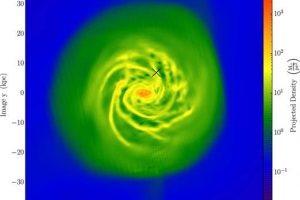Archeo-astronomy with the Gaia-ESO Survey. “The Gaia-ESO Survey: matching chemodynamical simulations to observations of the Milky Way” of B. B. Thompson recently published

Not all the archaeologists do their studies digging holes or classifying artifacts in dusty museums… some of them actually use telescopes…
Galactic archeology is a branch of astronomy dedicated to the study of the formation and evolution of the components of our Galaxy (bulge, bar, disc and halo) by analyzing ages, dynamics, and chemical abundances of stars. Not an easy task, given the large number of stars in the Milky Way (between 100 and 400 billions).
Despite the hard challenge, archeo-astronomy has achieved important results, improving our knowledge on how the Milky Way formed and how it has interacted with its environment (mainly the satellite galaxies, most of them merged with the Milky Way). However, this approach always requires the comparison between large stellar data sets and existing evolutive models of our Galaxy.
This is the contest of the study “The Gaia-ESO Survey: matching chemodynamical simulations to observations of the Milky Way” of B. B. Thompson, with the collaboration of astronomers of the Astronomical Observatory of Palermo, and recently published on Monthly Notices of the Royal Astronomical Society. In this study, the authors have analyzed the data from the Gaia-ESO Survey, the richest and most complete spectroscopic data set of stars in our Galaxy, comparing them with the galactic model called RAMSES-CH. The main result of the study is the evidence that the observed dispersion in chemical abundances and stellar ages, that existing models struggle to explain, are actually due to statistical uncertainties associated with the used data rather than on specific properties of the Milky Way.
This study, and the Gaia-ESO Survey, have made the life of archeo-astronomers slightly easier…
The figure (link) shows a simulated surface gas density of the Milky Way and the center of the region studied in this work
